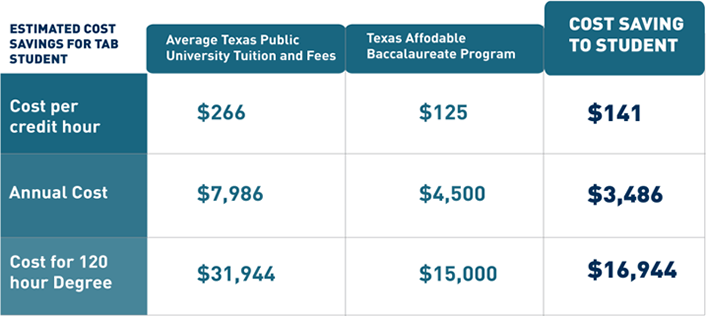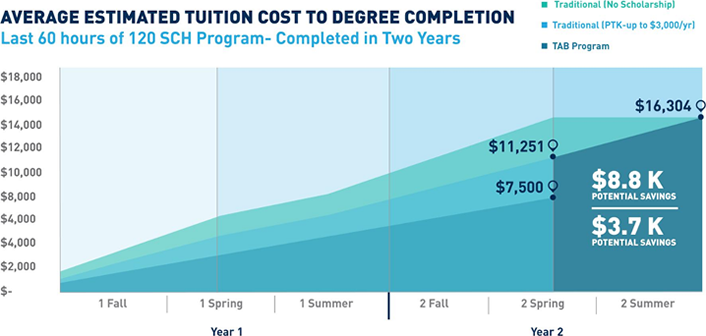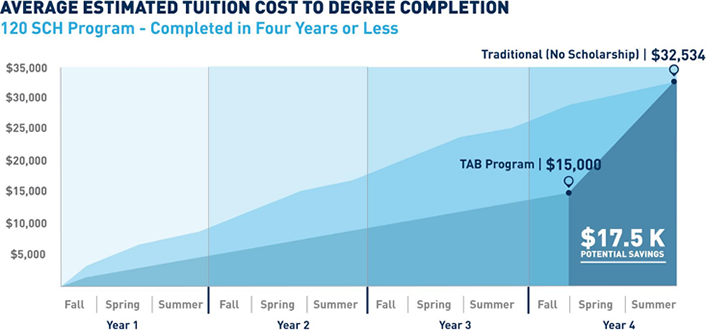Key Takeaways
-
Competency-based education offers the opportunity to accelerate learning and thus time-to-credential; alternative pricing structures such as all-you-can-take subscription models; and credit for prior learning.
-
The Texas Affordable Baccalaureate Program, a competency-based BAAS in Organizational Leadership at Texas A&M University–Commerce, illustrates how these time and cost savings can benefit students.
-
The TAMU-C Institute for Competency-Based Education will assist additional higher education institutions across Texas in developing their own TAB programs.
Affordability is one of many potential advantages for students engaging in competency-based education (CBE). The opportunity to accelerate learning and thus time-to-credential; alternative pricing structures such as all-you-can-take subscription models; and credit for prior learning may all afford cost savings for students. However, we still see a relative dearth of hard evidence to substantiate CBE's potential. In his 2015 report "The Landscape of Competency-Based Education: Enrollment, Demographics, and Affordability," Robert Kelchen pointed out:
Although the list prices of competency-based models appear very cost effective in relation to traditional higher education models, no one has comprehensively examined the true affordability of CBE programs and whether they actually deliver credentials to their students at a lower price.1
Preliminary research on the Texas Affordable Baccalaureate (TAB) Program, a competency-based BAAS in Organizational Leadership at Texas A&M University-Commerce (TAMU-C), suggests significant cost savings for students. Tuition and fees have remained fixed at $750 for Texas residents and $2,500 for non-residents for each seven-week term since January 2014, when the first class of students was admitted. This pricing model allows students to accelerate and complete as many courses as they can manage for no additional cost during each term of enrollment, an all-you-can-take buffet of courses for the same flat rate. In addition, since many students come to the program with an associate's degree or prior learning from the workplace or military, they also have options to satisfy some degree requirements through transfer credit or prior learning assessment (PLA), which can propel them to finish their degree even faster.
The Texas Higher Education Coordinating Board (THECB) and TAB Program staff members have built estimated cost scenarios for students in the program. A TAB student is not the typical "traditional" college student most people imagine. Of the current 305 students enrolled in the TAB Program, 88 percent are ages 25 and up, and 53 percent of all enrolled students receive some type of financial assistance, including but not limited to outside scholarships and employer reimbursements.2
Since its inception, the TAB Program at TAMU-C has yielded crucial data to track its programmatic and student performance, providing a model for other Texas public institutions of higher education to follow. Currently, the Institute for Competency-Based Education, also based at TAMU-C, is charged with developing appropriate, targeted metrics with which to track outcomes and to continuously collect data on the program and its students. Here we focus on student efficiency/affordability scenarios based on the 122 students who have graduated from the TAB Program. We hope these cost scenarios — which mirror a national trend toward using CBE to support affordability — help clarify how students can save both time and money through CBE models.
Figure 1 compares the costs of attending an average Texas public institution of higher education with the Texas Affordable Baccalaureate at TAMU-C.3 No matter the cost scenario breakdown, a TAB student could complete a bachelor's degree for around half the cost of a traditional program, with savings as high as 53 percent.

Figure 1. Cost-saving estimates for TAB students
Although designed to serve post-traditional students such as working adults, this program can support affordability for even "traditional" students with no prior higher education experience. As seen in figure 2, regardless of enrollment scenario, TAB students can accelerate time to degree by at least a year while saving money. However, most of the graduates fit into the third enrollment scenario in figure two: they have transferred in an average of 87 semester credit hours (SCH), and, once enrolled, the average cost to degree is $4,339.4 On average, TAB students have completed the program in less than a year or six terms, for a cost-to-degree savings of $8,720 compared to a traditional, non-CBE degree at TAMU-C, helping students transform debt they may have incurred in past (unsuccessful) pursuit of a higher education credential into a degree.

Figure 2. Cost scenarios for TAB students
Figure 3 shows potential cost savings for TAB students compared to traditional transfer students at TAMU-C, who complete in two years or less.5 Initial findings look quite promising: the graph below not only displays significant cost savings of roughly $8.8K versus all transfer students in general, but the TAB program, through its flat-rate model, also shows cost savings versus transfer students who receive up to $3,000 in scholarship support per year. TAB students save up to 33 percent more in comparison to students in the general transfer population who received a top-tier transfer scholarship.

Figure 3. Estimated tuition for three categories of TAB students
Figure 4 shows potential cost savings for TAB students compared to traditional first-time freshmen at TAMU-C, who complete in four years or less.6 The graph indicates cost savings of 54 percent in comparison to students in the traditional student population, with potential savings to degree completion of roughly $17.5K.

Figure 4. Estimated average tuition for TAB students
In addition, the financial aid allowance for texts for TAB students enrolled in 12 SCHs is $700, which would add additional savings for the lower-division curriculum. Students do not purchase books in this part of the program because the digital instructional materials are included in the flat-rate fee for the term. This is a conservative number, since with the financial model of the TAB program students don't have to pay additional fees, such as distance education, program delivery, lab, or other fees that students in traditional programs often incur. Also, since the program is offered 100 percent online, students could reduce expenditures including room and board, personal, and transportation; however, funds for these three components are distributed the same among all students, making the savings for TAB students come predominantly from tuition and textbook expenditures.
Although CBE programs effectively serve some traditional student populations, our targeted metrics continue to suggest that the TAB Program supports affordability for the increasing number of post-traditional students in particular, such as working adults who need the flexibility CBE offers. In addition, the TAB program has yielded institutional cost savings. For example, for upper division courses in traditional degree programs at TAMU-C, the total expenditure per FTSE is $11,824 versus $6,115 for upper division courses in the TAB Program, for a cost savings per FTSE of $5,709. Furthermore, the total expenditure per SCH for the TAB Program is $204; compared to the $394 expenditure for traditional programs across campus, this yields a cost savings of $190 per SCH.7
The TAB Program also supports more efficient use of financial aid. Transfer students in a traditional program at TAMU-C require on average $2,700 in financial aid for tuition of 12 SCHs during a 16-week period. Students in the TAB Program require $750 for at least six SCHs each seven-week term; therefore, for a comparable 12 SCHs scenario, they would require $1,500 in a 14-week period. The difference in financial aid distributed in tuition per term is approximately $1,200 for the same 12 SCHs. Thus, the federal funds available potentially could be disbursed to a larger portion of students through a CBE model, resulting in a more efficient use of these resources. The lower cost of the TAB program also can help students reduce the overall amount of student loans they receive, reducing their debt obligation following graduation and averting non-payments and potential loan defaults, which is a national concern.
Data from CBE programs at institutions like Capella University, Northern Arizona University, Southern New Hampshire's College for America, University of Wisconsin's Flex Option, and Western Governors University seem to suggest that for students, the most cost-effective programs are subscription-based, allowing them to accelerate time-to-degree for potentially significant cost savings.8 The 2016 College Affordability Diagnosis: National Report corroborates the "significant savings" that students who "progress quickly through many courses or modules might see."9 Of course, if a program is not eligible for federal financial aid, affordability could be diminished for those students relying on it. But partnerships with employers to offer tuition assistance can go a long way toward supporting affordability for the many CBE students who are working adults.
The BAAS in Organizational Leadership, through its navigation of accreditation, cost efficiencies, and other activities on the vanguard of CBE, has paved the way for similar programs across Texas, and the TAMU-C Institute for Competency-Based Education will assist additional institutions in developing their own TAB programs. While this article provides a brief overview of TAB student cost- and time-saving scenarios, the Institute is active in the CBE research community and committed to building partnerships to address the need for more comprehensive studies.
For more information, please contact authors Judith Sebesta ([email protected]) or Carlos Rivers ([email protected]).
Acknowledgments
This article includes tables from the "Texas Affordable Baccalaureate Expansion Initiative" report from January 2016, with estimates developed by the Texas Higher Education Coordinating Board. It also includes graphs created by Dr. Donna Smith, program director of the Texas Affordable Baccalaureate Program at Texas A&M University–Commerce, with enhanced artwork by Tatiana Chamorro. These charts were built based on data from this degree program, which is the state's first SACSCOC-approved competency-based baccalaureate degree offered by a public university.
Notes
- Robert Kelchen, "The Landscape of Competency-Based Education: Enrollment, Demographics, and Affordability," American Enterprise Institute, 2015, ii. Also see Uriel Kejsefman, Jon Barnhart, and John Tannous, "Financial Models for Competency-Based Education," Research Brief, Education Advisory Board Community College Forum, 2014.
- For more background and data on the program, see Carlos Rivers and Judith Sebesta, "Competency-Based Education and Predictive Analytics: Learning from Transfers," EDUCAUSE Review, July 11, 2016.
- Texas Higher Education Coordinating Board, "Texas Affordable Baccalaureate Expansion," January 2016. $266: The annual tuition and fees of $7,986 divided by 30 SCHs. Actual cost is $266.20. $125: That is, cost per seven-week term of $750 divided by the average of 6 SCHs earned by TAMU–Commerce and STC students per term. $7, 986: as reported in the Texas Public Higher Education Almanac 2015, 27. These are the cost of tuition and mandatory fees charged to a student who takes 30 SCHs (15 SCHs in the fall and 15 SCHs in the spring). These data are submitted to THECB on the College Student Budget Report. $4,500: That is, six seven-week terms annually at a cost of $750 per term. $31,944: That is, an annual cost of $7,986 multiplied by four years, assuming the average student completes 30 SCHs annually. $15,000: That is, a student with no prior higher education credits, earning an average of 6 SCHs per seven-week period, requiring 20 seven-week periods to complete his/her degree.
- Texas Higher Education Coordinating Board, "Texas Affordable Baccalaureate Expansion," January 2016. $15,000: That is, 20 seven-week terms, averaging 6 SCHs per term (as reported by TAMU–Commerce and STC), at a cost of $750 per term. $7,500: That is, 10 seven-week terms, averaging six SCHs per term (as reported by TAMU–Commerce and STC), at a cost of $750 per term. $3,750: That is, five seven-week terms, averaging six SCHs per term (as reported by TAMU–Commerce and STC), at a cost of $750 per term.
- Donna Smith, "Average Cost to Degree Completion," PowerPoint Slides, 2016. Traditional: Based on full-time enrollment of 12 SCHs in fall/spring plus six in summer; tuition and mandatory fees for 2016–17; does not include additional miscellaneous costs such as textbooks, enrollment fees, application fees, orientation fees, program fees, lab fees, and distance education fees. Traditional with scholarship: Based on full-time enrollment of 15 SCHs in fall/spring plus six in summer; tuition and mandatory fees for 2016–17; does not include additional miscellaneous costs such as textbooks, enrollment fees, application fees, orientation fees, program fees, lab fees, and distance education fees. TAB Program: Based on full-time enrollment of six SCHs per term for 12 terms (average six terms in a year); miscellaneous costs such as textbooks, enrollment fees, application fees. Organizational Leadership estimated book costs for applied major courses are approximately $800; enrollment and graduation fee is $100.
- Donna Smith, "Average Cost to Degree Completion," PowerPoint Slides, 2016. Traditional: Based on full-time enrollment of 12 SCHs in fall/spring plus six in summer; tuition and mandatory fees for 2016–17; does not include additional miscellaneous costs such as textbooks, enrollment fees, application fees, orientation fees, program fees, lab fees, and distance education fees. TAB Program: Based on full-time enrollment of six SCHs per term for 12 terms (average six terms in a year); miscellaneous costs such as textbooks, enrollment fees, application fees. Organizational Leadership estimated book costs for applied major courses are approximately $800; enrollment and graduation fee is $100.
- THECB, Texas Public University Expenditure Study Fiscal Year 2015, Institution Survey for the Year Ended August 31, 2015, Texas A&M University–Commerce, January 2016.
- Kelchen, 13–15.
- Darcie E. Harvey, "Cultivating Innovation: Promising State Policies and Programs for Increasing College Affordability," College Affordability Diagnosis: National Report (Philadelphia: Institute for Research on Higher Education, Graduate School of Education, University of Pennsylvania, 2016), 26.
Carlos Rivers, MBA, is an operations research analyst in the Institute for Competency-Based Education, Texas A&M University–Commerce.
Judith Sebesta, PhD, is executive director of the Institute for Competency-Based Education, Texas A&M University–Commerce.
© 2016 Carlos Rivers and Judith Sebesta. The text of this article is licensed under Creative Commons BY-NC-ND 4.0.
